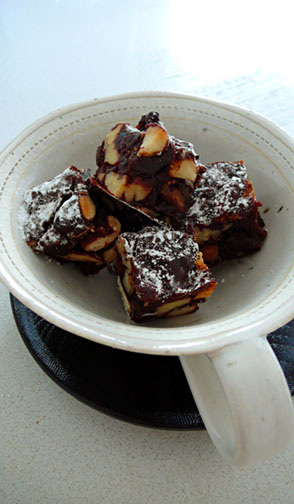A very edible Christmas
I love you through sparks and shining dragons, I do,
now there’s poetry, in an empty coke can.
I love you through sparks and shining dragons, I do,
now there’s majesty, in a burnt out caravan.You got me off the paper round, just sprang out of the air,
the best things come from nowhere,
I love you, I don’t think you care.I love you through sparks and shining dragons, I do,
and the symmetry in your northern grin
I love you through sparks and shining dragons, I do,
I can see myself in the refill litter bin.You got me off the sofa, just sprang out of the air, the best things come from nowhere, I can’t believe you care.
–Made-Up Love Song #43 by The Guillemots
Christmas gets here too quickly, I’ve decided. In March, you can’t imagine making it to the end of the year and every month seems to dribble by. Then suddenly it’s the 24th of December and you’re frantically pacing around Westfield, wondering what to get Aunt Jan for Christmas.
For me, Christmas isn’t so much about the actual day itself, as the build up to the day. Christmas Day often takes place in a blur of excessive eating and gift unwrapping. But in the lead up to Christmas, the excitement gathers pace particularly in the kitchen as we bake off an assortment of treasures that I associate with Christmas : gingerbread, panforte, fruit cake and pain d’epice.
This year has been particularly busy for me at work, and now that things are almost slowing down a little, it feels as though a great weight as been lifted off my shoulders. Good bye to rising at 4 and 5 in the morning for work, though I must say it has been very character-building, in it’s own adorable little way. To celebrate having two days off in a row, I’ve been dancing around in the kitchen, listening to the Guillemots and Sufjan Stevens, decorating little gingerbread biscuits I made a few days ago. The inspiration came from a recipe for gingerbread men by Andrew McConnell in last week’s Good Weekend magazine. Instead of men, I made stars and snowflakes, and just for something a little bit unusual, the Sydney Harbour bridge. The bridge cutter was one I rescued from a bargain bin at Chefs Warehouse several months ago, but never found an excuse to use until now.
The biscuits are either slightly chewy if you roll them out thick, or more of a gingersnap, if rolled thinner. (I was a bit of a greedy child and when my sister and I used to make gingerbread, mine would often be slightly thinner; the logic being that I was actually yielding more biscuits. But these days I like my gingerbread to be on the thicker side so that it’s more bread and less biscuit). Below is the original recipe, which is meant to make 12 large gingerbread men, or more than enough small stars and snowflakes to fill the sky.
These gingerbread biscuits are my contribution to Francesca’s Waiting for Christmas event.
[Note: My smaller sized biscuits took less than the recommended baking time. Also if like me you like your spice, I would increase the spice content (and at least double the volume on your stereo speakers to get you in the mood!)].
Gingerbread Men :
200g butter
90g white sugar
90g soft brown sugar
1/4 cup molasses
2 tsp cinnamon
1 tsp ground ginger
4 whole cloves, pounded in the mortar
1 egg
550g plain flour
2 tsp bicarbonate of soda
pinch salt
Cream the butter and sugar together. Add the molasses, spices and egg and mix well.
Sieve together the flour, bicarb soda and salt, and add to the butter and egg mixture a bit at a time, stirring well after each addition.
Knead the dough a couple of times to make sure it is well mixed and refrigerate for 1 hour.
Then, on a floured bench, roll out the dough, in small batches, to about 3mm thick. If you are making large gingerbread men you may need to roll the dough out a bit thicker. Using a cookie cutter, cut out as many gingerbread men as your dough allows.
Place them on a tray lined with a sheet of baking paper. Bake in a preheated oven at 180’C for 12 minutes or until the edges are slightly browned. Cool on a wire rack, then ice as desired.
The biscuits will keep in an airtight container for up to a week.
Royal Icing :
(recipe from Rose’s Christmas Cookies, by Rose Levy Beranbaum)
3 large egg whites (90g)
460g pure icing sugar
In a large mixing bowl, place the egg whites and sugar and beat, preferably with the whisk beater, at low speed, until the sugar is moistened. Beat at high speed until very glossy and stiff peaks form when the beater is lifted (5 to 7 minutes). The tips of the peaks should curve slightly. If necessary, more icing sugar may be added. Keeps 3 days in an airtight container at room temperature. Rebeat lightly.










